Are you looking into dental bridge costs in the UK? Which, on average, can range anywhere from £280 to £3,200. But perhaps you’re looking for a little more detail or exploring various dental bridge options, such as cantilever and Maryland bridges?
Whether you’re considering the NHS or private options, understanding the dental bridges is crucial in making an informed decision.
Our comprehensive guide will delve into common questions surrounding dental bridges, such as:
- What is a dental bridge?
- How does a traditional fixed dental bridge differ from a bonded teeth bridge?
- Can you opt for a dental bridge for front teeth?
- What is the typical tooth bridge cost in the UK?
- How can you get a dental bridge through the NHS?
- What potential problems might I get with dental bridges?
We’ve created this inclusive guide to teeth bridges, providing you with the answers to all those important questions. Keep reading to learn more about the dental bridge variations in the UK. At Dentaly.org our goal is to empower you to make an informed decision about whether a dental bridge is the most suitable dental restoration for your needs.

Save the trip to your NHS dentist and speak to a certified dentist right now online. Visit JustAnswer to chat online with a qualified dentist and find out all the information you need – without having to take time out for a dental appointment.
Their dentists are based in the US and are available 24/7 to help you out!
What is a dental bridge?
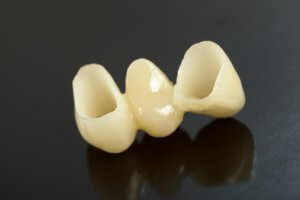
In simple terms, a dental bridge as a type of prosthetic tooth which literally bridges the gap between two teeth. If you have lost a tooth or two, through decay or because of an accident, a bridge can make your smile complete again.
Where more than two teeth in a row are missing, an implant-supported bridge may be an option – but we will come back to that later.
If you have lost one or more teeth, you have likely noticed a negative effect on the function, appearance, and health of your smile. You may find it more difficult to speak, chew, and eat as normal, or you may feel embarrassed about your smile because of the gaps left by missing teeth.
Under these circumstances your dentist may recommend a dental bridge. When in place, a bridge can improve your smile by:
- Restoring the natural shape and volume of your face
- Improving your ability to properly chew, speak, and eat
- Enhancing the beauty of your smile
- Preventing the remaining teeth from moving into the space left by the missing teeth
- Relieving uneven stress on the bite
- Replacing an unwanted removable partial denture
Dr. Robert Berry, Mountain Aire Dentistry
Dental bridge materials
Tooth bridges come in a variety of materials and finishes. Here’s a quick look at the advantages and disadvantages of each:
Metal only
Metal alloys are usually the cheapest option, but they have the obvious disadvantage of looking nothing like natural teeth. If the retainer and pontic won’t be too visible when you smile, a metal tooth bridge could be a good choice.
Ceramic only
Porcelain, ceramic and zirconium bridges, when made well, look exactly like natural teeth. They are therefore the preferred materials for a front tooth bridge. However, they come at a much higher cost because of the materials and lab work involved.
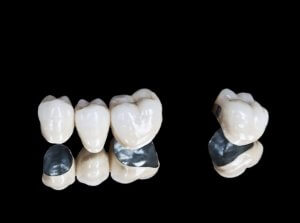
When first introduced, ceramic bridges suffered from lack of durability. But thanks to modern technology and materials used in dentistry, they have become much stronger.
Emax bridges are slightly stronger than other all-ceramic made bridges because they are made from a single block of lithium disilicate ceramic. This material is more aesthetic and natural-looking than others because of its slightly translucent appearance. Learn more about these types of crowns and bridges in our full guide here.
Porcelain fused to metal (PFM)
A solution that balances cost with appearance is a bridge made from ceramic or porcelain fused to a metal base (as pictured). This type of bridge can lose its aesthetic appearance over time, as the ceramic thins and exposes the metal underneath.
A PFM bridge also may not be as strong as pure ceramic. The best material for your dental restoration will depend on your budget and the position of your missing teeth.
We look forward to being able to help you save up to 70% on the dental care you need!
Types of dental bridges
Traditional tooth bridges use the adjacent teeth as anchors for the prosthesis. There are two ways to fit a bridge to the existing teeth: fixed or bonded.
Conventional fixed bridge
A fixed bridge is the most common type of dental bridge as it provides a strong, durable way to replace one or two adjacent teeth.
The prosthesis used for a fixed bridge consists of a crown on either side and one or two pontics (artificial teeth) in the middle. The crowns are hollow and fit over the neighbouring teeth to secure the bridge in place.
Traditional dental bridge procedure
In order for the crowns to fit properly, the anchor teeth must be filed down from their original size as part of the dental bridge procedure. These two teeth have to be strong enough to support the bridge and take the extra biting pressure. Dentists may perform root canal treatment on the anchor teeth before removing the necessary amount of enamel.
After preparing the anchor teeth, the next step in the dental bridge procedure is to take a dental impression. This is sent to a laboratory where your bridge is precisely made to measure. In the meantime, your dentist may provide a temporary dental bridge or crowns to protect the exposed teeth and gums.
The video below shows just how many steps are involved with dental bridge construction in the lab:
Once your permanent bridge is ready, your dentist will position it in your mouth and ask you to test how it feels. Provided you’re happy with the fit, your dentist will fix it in place using a strong dental cement. Further visits are sometimes required to improve the fit, but not always.
The main drawback to a fixed bridge is having to ‘sacrifice’ two healthy teeth. If you later decide to replace your tooth bridge with an implant, the adjacent teeth will require crowns since removal of enamel is permanent.
You’ll also need to take special care when cleaning and flossing around your bridge. Using a water flosser can make the process quicker, easier, and more effective.
Aside from that, a fixed bridge is a strong and durable solution. If you opt for a ceramic or porcelain bridge, nobody should be able to spot that the teeth aren’t natural.
Front teeth bridge
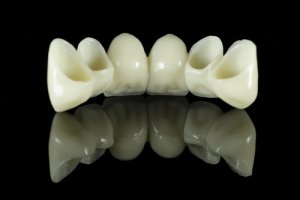
A dental bridge for front teeth may require two crowns on either side, since the biting pressure on the front incisors is so great. The result is a five- or six-unit dental bridge to replace one or two teeth.
If you are missing one or more front teeth, or have been told you need to have teeth removed, your dentist will be able to advise you on the best type of front tooth bridge for you.
Fixed-movable tooth bridge
The type of traditional bridge described above is sometimes called fixed-fixed to differentiate from fixed-movable. A fixed-movable bridge is still anchored in place but the joins between the retaining teeth and the pontic are not rigid. By allowing a small amount of vertical movement, less pressure is placed on the supporting teeth. There may also be less tooth preparation required.
Cantilever bridge
Similar to a traditional dental bridge, a cantilever bridge is attached via a crown on just one of the adjacent teeth. This type of bridge might be used when there is only one natural tooth next to a missing tooth.
One benefit of cantilever bridges is they only require one healthy tooth to be drilled into an abutment. On the other hand, they aren’t as strong as a bridge with two supporting crowns. They can place extra pressure on the supporting tooth, leading to more problems later on. As such, cantilever bridges are usually not used in locations that take a lot of pressure from biting and chewing.
Bonded bridge (Maryland bridge)
When there is only one tooth to replace, your dentist may fit a resin bonded bridge (also called a Maryland bridge).
Rather than being fitted over the adjacent teeth with crowns, this type of bridge has metal or porcelain ‘wings’ on each side which are bonded to the inner edge of the adjacent teeth.
A bonded bridge of course has the advantage of preserving the healthy adjacent teeth. The main downside is that it won’t be as strong as a fixed bridge. Over time the adhesive holding it in place can weaken, causing the bridge to break off or become loose.
With any type of bridge for teeth, it is only the crown of the tooth that is being replaced. The root remains absent, and this can cause the jawbone to recede over time.
Long-term, this may cause sagging around the face. If you choose to have implants at a later date, you may first need a bone graft. This is really the main dental bridge problem that patients need to be aware of.
Dental bridge vs. implant vs. denture
Tooth bridges, implants and dentures are all dental solutions for the replacement of missing teeth. Each offers advantages and disadvantages over the others, which we have summarised below.
Teeth implants
Dental implants are placed directly into your jawbone, where your tooth root would have been. They are usually made from titanium, a very strong material which is biocompatible with our bodies (meaning there should be no allergic reaction or rejection of the implant).
An abutment is fitted to the implant, and this is what holds the crown (the replacement tooth) in place.
The main benefits of implants over bridges are:
- They don’t affect the adjacent teeth
- They are a more durable solution and can last a lifetime
- It’s easier to maintain good oral hygiene with an implant (less chance of decay and gum disease)
- They help maintain the structure of the jawbone and the shape of the face
On the downside, implants require some surgery and are more expensive than a bridge fitted over teeth. If you take into account the lifetime cost and inconvenience of replacing your tooth bridge, though, an implant may work out to be a good investment in the long run.

Treatment time is another consideration for some patients. The process for placing a traditional tooth implant takes several months, as the implant needs time to settle and fuse with the bone before the abutment and crown are attached. For some patients this is just too long to wait, so a bridge is the better solution.
If you are missing a tooth because of trauma, you may need additional time to heal before the implant process commences.
The animation below shows the process for fitting a 3-unit bridge compared to a single-tooth implant:
Implant-supported bridges
For patients who are missing several teeth in a row or whose remaining teeth aren’t healthy enough to be used as anchors, bridged implants may be an option. Dentists can install implants in place of anchor teeth and then fit a bridge (made from two crowns and one or two pontics) over them.
This option is more cost-effective than replacing each tooth with an individual implant, since it uses fewer implants.
Dentures
Dentures are what most people think of as ‘false teeth’. They consist of one or more prosthetic teeth, traditionally fixed to a frame made from plastic and metal which clips around existing teeth. Newer flexible denture materials are also available.
The versatility of dentures means they can be made to fit around any number of remaining healthy teeth.
Although partial denture costs are quite low, making them the most affordable option when it comes to replacing a missing tooth, they are also the least convenient to live with. They require special cleaning, and may become damaged or dislodged by certain foods.
Because of the way our mouths change over time (especially when teeth are missing), dentures may only last for a few years before coming loose. If they are not replaced, they can become uncomfortable and cause mouth sores. There is also a chance of them slipping out mid-conversation.
Comparing the options
Below is a comparison table for the tooth replacement options described above:
Dental bridge | Dental implant + crown/bridge | Partial denture | |
Permanency | Fixed to adjacent teeth; non-removable | Implanted in the jaw bone, fixed in place | Removable |
Longevity | 5-15 years, possibly longer | 20+ years | 5-10 years, possibly longer |
Comfort | Like natural teeth if fitted well | Like natural teeth | May become loose over time and cause discomfort |
Appearance | Like natural teeth (unless metal) | Like natural teeth | May look artificial; metal clips may be visible |
Function | Like natural teeth | Like natural teeth | Certain foods must be avoided; remove to clean |
Cost (private) | Medium | High | Low |
Cost on NHS | £282.80 | N/A | £282.80 |
Other pros/cons | Requires removal of enamel on neighbouring teeth | Involves surgery; small risk of infection | Can slip out of place; easy to lose or damage while removed |
How much does a dental bridge cost in the UK?
The cost of a dental bridge in the UK ranges from £280 to £3,200, on average. That’s a big price difference, but it all depends on:
- Whether you see a private or NHS dentist
- Whether you get a 3 or 4-unit bridge
- The materials used
- The type of bridge placed
You’ll need to speak to your local practice and perhaps have a consultation before you can get a personalised dental bridge cost estimate. Your dentist will certainly want to check your mouth and the state of your remaining teeth before confirming your treatment plan.
So we can’t tell you the exact cost of a tooth bridge in the UK, but there’s some more information below which will help you estimate the cost for your treatment.

Can you get a dental bridge on the NHS?
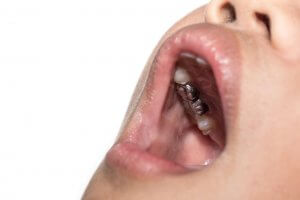
Yes, dental bridges are one of the tooth replacement treatments offered on the NHS. If you are missing one or more teeth, you may be offered a tooth bridge or a partial denture. However, you must remember, in order to receive a dental bridge NHS criteria must be met, so make that appointment with your dentist to find out if you are suitable.
One downside of NHS dental bridges is you won’t get a choice of materials. Your dentist will select the most clinically suitable material. A dental bridge for front teeth on the NHS will probably be made from porcelain fused to metal (PFM), giving it a tooth-coloured appearance. For back teeth, either PFM or all-metal bridges may be offered.
If your NHS dentist only offers you a metal dental bridge and you would prefer a tooth-coloured one, you’ll need to pay for private treatment.
What does an NHS bridge cost?
The cost of a dental bridge with an NHS dentist is £282.80 in England – the band 3 treatment charge. This price remains fixed regardless of how many teeth you have treated – view full NHS dental prices in the UK. Only certain types of tooth bridge are included with NHS treatment, though.
If you are unable to find an NHS dentist accepting patients, or you are ineligible for NHS treatment for some reason, you can visit a private dentist to get a bridge for your teeth.
How much does a bridge cost at a private dentist in the UK?
Private dentists usually apply a charge per unit for fixed bridges. If you’re replacing one tooth you’ll need a three-unit bridge – unless you are eligible for a cantilever bridge requiring just two – and replacing two teeth will require four units.
Although private bridge costs can be more expensive, you’ll have more choice over the materials used and won’t have to deal with NHS waiting times.
The table below gives an idea of what you can expect to pay for different types of bridge with a private UK dentist:
Type of bridge | Average cost (private treatment) |
Traditional fixed crown and bridge | £250 - £800 per unit |
Bonded bridge | £350 - £1,000 |
Implant-supported bridge (2 implants, 3-unit bridge) | from £3,500 |
As you can see, the cost of a dental implant bridge is usually the highest. But since implants are a long-lasting solution, they may work out more cost-effective over the life of the restoration.
Saving money on dental bridge costs
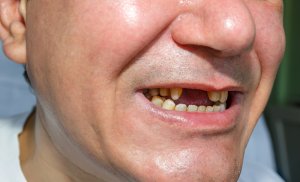
One way to save money on dental bridges, especially if you are getting implants, is to go abroad for dental treatment. Teeth bridge costs and other dental care can be 50-70% less in countries like Hungary and Turkey, yet the standard of care is often greater than you’re used to at home.
The idea of travelling overseas for dental work may seem daunting, but you can use a company like Dentaly Go to help you through the process. They are experts at helping Brits find high-quality dental treatment abroad at affordable prices, and you can request a quote absolutely free.
Teeth bridges are commonly covered by dental insurance policies in the UK, too. If you already have insurance, check whether your provider will make a contribution towards your dental bridge costs.
Not got insurance? How much does a dental bridge cost without insurance?
We recommend not taking the risk to find out, without insurance your looking at covering the whole cost of treatment alone.
Our dental insurance guide explains more about the options and what to consider when taking out insurance. Be aware that many policies have a waiting period that applies before you can claim for restorative treatments like teeth bridges. This might be 3, 6 or 12 months, for instance, so only go ahead if you’re happy to wait that long before getting treatment.
A dental loan or credit card can help you fund your dental work if you don’t want to wait while you save up for it.
Possible dental bridge problems
Although teeth bridges are a great way to replace missing teeth, of course complications can occur – just like with any kind of dental treatment. If you’re worried about dental bridge risks, here are some of the most common dental bridge problems you might encounter.
Infection under dental bridge
There are three main causes of infection under and around a tooth bridge:
- Poor oral hygiene
- A poorly fitting bridge irritating the gums
- Decay in the supporting teeth
When you first get your tooth bridge fitted, your dentist will advise you how to keep it clean. Following this advice will help you avoid complications with infection in the surrounding teeth. If you think your dental bridge is infected, visit your dentist before it develops into something more serious, like an oral abscess.
Sensitivity under dental bridge
Your mouth and gums need to get used to the shape of your new teeth, so it’s normal to feel some sensitivity around your teeth and gums for a few days after having a dental bridge placed. This is especially true if you had root canal treatment as well.
If sensitivity continues for more than a couple of weeks, it may be due to a problem with the placement of the tooth bridge. It’s best to visit your dentist so they can assess the situation. Also see your dentist if you start experiencing sensitivity or pain under an old dental bridge.

Food caught under dental bridge
You will need to take extra care when cleaning around your dental bridge, since food can get stuck in the small spaces between the pontic and gum. Not only is this uncomfortable; it will soon start to smell bad and breed bacteria that cause decay.
Using a water flosser will help you dislodge any food caught under your dental bridge. The Waterpik Ultra, for example, is a popular model which is gentle yet effective at cleaning around teeth bridges and crowns.
Metal appearing at base of teeth
One of the downsides of a porcelain fused to metal (PFM) bridge is that over time, the porcelain can wear away to reveal a line of metal at the gum line. This is not necessarily a sign that there is something wrong with the bridge, but it can be unsightly, especially with front teeth.
Your dentist can advise you of the best course of action, depending on the overall condition of your bridge. If you want to avoid this problem, opt for an all-ceramic tooth bridge instead of one that contains metal.
Dental bridge feels tight
It will take you some time to get used to the feel of your new tooth bridge. It may feel tight – even painful – at first because there is extra pressure on the supporting teeth. If this feeling doesn’t settle down after a week or so, feel free to mention it to your dentist.
Dental bridge feels loose
If your dental bridge feels loose straight after it’s been fitted, your dentist will need to re-cement it. If you feel your tooth bridge moving around, book an appointment straight away so it can be fixed before any damage occurs.
Over time, the dental cement that holds a tooth bridge in place will start to fail and this may cause an old bridge to feel loose or even fall off. It may be possible to re-cement it if the supporting teeth are still in good condition; otherwise it will have to be replaced.
How to fix a loose dental bridge at home
You can buy dental bridge repair glue online, like this glass ionomer luting cement. Follow the instructions carefully and it might be enough to keep a bridge or crown in place for several months.
One customer shares her experience with this product: “My bridge came off the day after Dentists closed for lockdown. Not knowing how long it would last I decided to take the situation into my own hands. Thank goodness I did! The kit is very straightforward and easy to use. The bridge hasn’t moved since replacing it. Very pleased with the results.”
Using dental glue to fix your bridge at home is rarely as effective as getting it treated professionally. Only use this as a temporary solution while you’re waiting to see your dentist.
Conclusion
Since both dentures and bridges for teeth are covered by the NHS for UK patients, getting a prosthetic tooth needn’t break the bank. For those who want a natural-looking, permanent way to fill a gap between teeth, a dental bridge may be the best option. Once fitted, you can forget that it isn’t one of your natural teeth (except for taking extra care to clean it).
There are several types of dental bridges available in the UK. You may have a preference based on price or procedure, but your dentist will ultimately be the one to decide what is the best solution given the position of your missing teeth.
Implants are an even longer-lasting solution and they help retain the patient’s jaw bone and facial shape. However, implants are only available privately so cost a lot more. Fortunately, there are ways you can save money on dental implants if this is the option you would prefer. You can read more about dental bridges vs implants in our separate guide.
If the cost of dental implants is holding you back from getting this treatment, remember you can save 50% or more by travelling abroad for your dental work. In countries like Turkey, you could get a dental implant for less than the cost of a bridge in the UK. Get a free quote from Dentaly Go if you’re interested in finding out more.
Get a free quote for dental treatment abroadDental bridge FAQs
Can you remove a dental bridge?
No, a dental bridge is designed to be fixed in place permanently. If your dental bridge has a poor fit, your dentist may be able to remove it and re-cement it for a better fit. Dentures, on the other hand, can be removed at any time.
How long does it take to get a dental bridge?
Depending on the technology your dentist uses, it can take a few hours or a few weeks to make a dental bridge. You’ll need at least two appointments with your dentist for the procedure. If it’s important you get your new false tooth bridge quickly, check with a few dentists about their processing time.
Is getting a dental bridge painful?

The dental bridge procedure itself will be done under local anaesthetic. You may experience a little discomfort from the injection and during the procedure, but it shouldn’t be painful at all.
You may experience temporary dental bridge pain or sensitivity for a few days after the procedure, though.
How long does it take for a dental bridge to settle?
Your new bridge may feel strange for a few days or weeks as your mouth gets used to it. During this time you might experience sensitive teeth and gums but speak to your dentist if it doesn’t resolve over time.
If you’re experiencing severe pain or your bridge is affecting your natural bite, mention it to your dentist as soon as possible.
How long does a dental bridge last?
All being well, a tooth bridge can last 10-15 years or more. A study of 80,000 patients found that 72% of conventional dental bridge abutments survived past 10 years. This is about the same survival rate as dental crowns. After this time, the materials begin to deteriorate and the supporting teeth are at greater risk of decay. Your dentist will check your bridge at your dental checkups and will let you know when it needs to be replaced.
The cost of replacing a dental bridge can add up over the years, so you might consider making the investment in dental implants instead. Implants last much longer – possibly for a lifetime – so can be more cost effective in the long run.
What should I do if I swallowed my dental bridge?
If a tooth bridge becomes dislodged while you’re eating or sleeping, you may accidentally swallow it. Don’t worry – you’re certainly not the first, and certainly not the last to do this.
Many people who swallow a tooth bridge find that it passes naturally without any problems. However, it’s best to visit your doctor, especially if nothing has emerged after 2-3 days, because it can get caught in your digestive system and lead to more serious problems.
What are the different types of dental bridges?
A conventional fixed bridge sits over two retainer teeth, while a cantilever bridge uses just one. A Maryland (bonded) bridge attaches via ‘wings’ at the back. Other types are less often used. We have more details about each of these further up the page.
What does a Maryland bridge cost in the UK?
A resin bonded Maryland bridge costs between £350 and £1,000 on average. It only requires one false tooth, which is why it’s a cheaper option than a traditional bridge.
How much does a dental bridge cost for 3 teeth?
A 3-tooth dental bridge is designed to replace one missing tooth; the other two units are the retainers which sit over natural teeth. This type of bridge costs between £750 and £2,400 depending on the materials used.
If you need to replace three missing teeth in a row, an implant bridge might be a better option. This will cost £3,500 or more but is a longer-lasting solution.
What does a 4-tooth bridge cost in the UK?
A 4-unit dental bridge to replace two missing teeth will cost between £1,000 and £3,200, depending on whether it is made from metal or porcelain, and which dental practice you go to.
British Society for Restorative Dentistry: CROWNS, FIXED BRIDGES AND DENTAL IMPLANTS. Consulted 27th May 2020.
University of Rochester Medical Center – URMC: Bridges. Consulted 23rd April 2019.
National Library of Medicine: Ten year survival of bridges placed in the General Dental Services in England and Wales. Consulted 13th November 2020.





